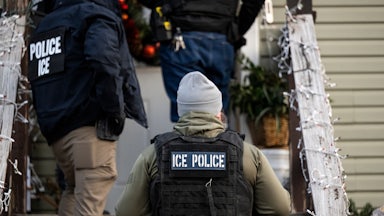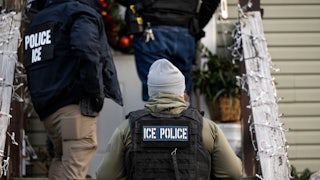West Virginia Senator Joe Manchin is usually pretty good at hiding exactly how he feels about policy issues. Strategic ambiguity has allowed him to survive as a Democratic senator in a deep-red state. So it was remarkable last week when he stated bluntly why he wants Congress to take action on compensation for student-athletes.
“It’s getting hard to root for the kids when they’re multimillionaires as freshmen and sophomores,” he told witnesses and colleagues at a Senate Judiciary Committee hearing. He urged the gathered figures, who represented different interests across the college sports world, to take action or “we’re going to lose one of the greatest pastimes we’ve ever had.”
The subject of the hearing involved so-called “name, image, and likeness deals”—also known as NIL deals—and the NCAA’s desire for Congress to regulate them. Lawmakers have held at least 10 hearings on the subject over the past two years and have introduced multiple bills to address them. Lurking in the background of the hearing, however, was the fear that courts and federal agencies will treat college athletes as workers and allow them to unionize.
Putting an end to the threat of unionized college athletes is a priority for Manchin, the NCAA, the athletic conferences, and the schools themselves. Charlie Baker, a former Massachusetts governor who became the NCAA’s president earlier this year, told the committee that he wanted Congress to “codify current regulatory guidance into law by granting student-athletes special status that would affirm they are not employees of an institution.”
Jack Swarbrick, the athletics director at the University of Notre Dame, said that college athletics “is in crisis” and warned that if Congress did not act, it could imperil college athletics programs’ fiscal health and endanger America’s ability to win Olympic medals. He also argued against unionization as a means of achieving competitive equity in college sports, arguing that “the potential for traditional collective bargaining to solve rulemaking challenges is not a basis to justify calling students something they are not, namely employees.”
The NCAA’s fear is a legitimate one. It’s also a new worry for them. In 2015, the National Labor Relations Board unanimously turned away an attempt by football players at Northwestern University to organize. That decision was attributed to Northwestern’s status as the only private school in the Big 10 Conference at the time. Since the board thought it didn’t have jurisdiction over athletes at state-run universities, it concluded that “asserting jurisdiction over a single team would not promote stability in labor relations across the league.”
A lot has changed since that ruling, however. In 2021, the Supreme Court’s unanimous ruling in NCAA v. Alston upended the economics of college sports. The justices held that schools could not stop students from earning money from NIL deals and brushed aside the NCAA’s claim that amateurism allowed it to circumvent federal antitrust laws. To make matters worse for the NCAA, Justice Brett Kavanaugh wrote a concurring opinion where he signaled his willingness to hear further antitrust challenges to the organization’s business model.
“Nowhere else in America can businesses get away with agreeing not to pay their workers a fair market rate on the theory that their product is defined by not paying their workers a fair market rate,” he wrote. “And under ordinary principles of antitrust law, it is not evident why college sports should be any different. The NCAA is not above the law.” While Kavanaugh is only one vote among nine, he is also the court’s current median vote. Some of the other justices’ pointed questions during oral arguments suggested they may be willing to side with him.
The Alston ruling kicked off a scramble for NIL deals, as well as a rush to set rules to regulate them. While the NCAA tried to set guidelines for athletes to accept them, so did various state legislatures on behalf of student-athletes at their public universities. “While we have all seen great positive impacts, I continue to hear from students that the patchwork of nearly 30 state laws is incredibly confusing for them to navigate and that it would be helpful to have some protections from unqualified and unaccountable actors who don’t have their best interests in mind,” Baker told the committee last week.
While its focus was on NIL deals and other ancillary forms of compensation, the Alston ruling also unsettled other aspects of the legal landscape surrounding college athletics. A federal judge in Pennsylvania, citing Alston a few months after the court’s ruling, rejected the NCAA’s bid to dismiss a federal lawsuit that sought to recognize that college athletes counted as “employees” under the Fair Labor Standards Act, which generally sets minimum workplace standards. That ruling, which is currently being reviewed by the Third Circuit Court of Appeals, would open the door to a wider range of worker protections for college athletes.
One of those protections would be the right to organize and collectively bargain. In September 2021, the NLRB announced that it would recognize some college athletes as employees under the National Labor Relations Act, which governs labor-management relations across the country. That conclusion allows the NLRB to impose sanctions on schools for violating their students’ rights to organize.
“Players at Academic Institutions perform services for institutions in return for compensation and subject to their control,” Jennifer Abruzzo, the NLRB’s general counsel at the time, said in a statement. She added that her memo on the matter hoped to “help educate the public, especially Players at Academic Institutions, colleges and universities, athletic conferences, and the NCAA, about the legal position that I will be taking regarding employee status and misclassification in appropriate cases.” Abruzzo said she used the phrase “Players at Academic Institutions” because the term “student-athletes” was “created to deprive those individuals of workplace protections.”
The NLRB may have to take on the matter sooner rather than later. Dartmouth College’s men’s basketball team filed a petition with the board in September to organize a union, which would be one of the first of its kind in the nation. That move is strenuously opposed by Dartmouth, which urged the board in a hearing earlier this month to reject the petition and preserve the students’ nonemployee status. The school’s lawyers argued that Dartmouth athletes are students first and athletes second, promoting a vision of college athletics that may be out of step with modern realities.
Other unionization bids could be imminent. Last week’s hearing also included witnesses who argued that the focus on NIL deals came at the cost of ignoring deeper issues in college sports. Ramogi Huma, the executive director of the National College Players Association, told Congress not to ignore episodes of sexual abuse of athletes, poor safety standards, low graduation rates, and other pressing concerns.
“College athlete name, image, and likeness … pay is the smoke that hovers above the raging fire of injustices at the core of NCAA sports,” she told the committee. “College athletes’ economic, academic, and physical well-being continue to be consumed by an insatiable greed and a mentality that treats players as property rather than people.”
Those issues would be disturbing in any industry. That they occur in one where athletes bring in billions of dollars for their schools and receive almost none of those proceeds themselves is particularly galling. With the legal landscape now shifting in their favor, it won’t be surprising if college athletes seek union membership as a way to ensure better conditions—unless the NCAA and its allies can get Congress to stop them, of course.










